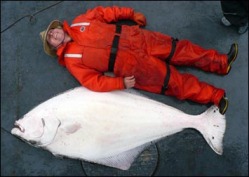HALIBUT

Commercial halibut fishing began in the 1890's with company-owned steamers carrying several small dories (two-man row boats), from which the fishing actually was conducted. Thereafter, smaller 60' to 100' schooner type boats, specifically designed for halibut fishing, were used in the fishery carrying crews of 5 to 8 deckhands. Most halibut boats used today are more versatile and also take part in the salmon and crab fisheries. Halibut fisheries have changed dramatically over the past several decades. In the 70's, halibut was fished for during a 5 month season. In the late 80's, only two openers of 24 to 48 hour lengths were available. This "derby style" fishing produced huge landings but low quality catch, not to mention, the extraordinary risks fishermen took during these short periods to secure their seasonal income. In 1995, halibut fishing switched to an individual vessel quota system which has increased the availability of fresh halibut to an 8 month annual span, while also increasing the quality of the halibut landed. Today, commercial Pacific halibut fishing is regulated by the IPHC. Members from the U.S. and Canada meet yearly to review research, check progress of commercial fishery, and make new regulations. This management is intended to allow maximum sustained yield of halibut.
|
|
|
|
|
|
|



